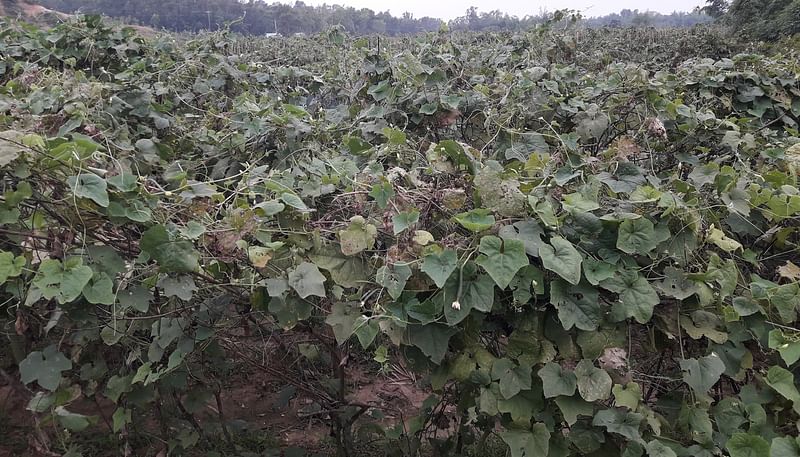Jingekhet is spread everywhere in the village. On both sides of the road, gray-green fields spread between houses and hills. The bamboo kanchi, the dry branches of the tree are wrapped in the Jing bush. There are different sizes of jinga, jinga flowers hanging on the trees.
Mohammadnagar of Baralekha Upazila of Moulvibazar has become Jinger village. Jing has been cultivated commercially in the village for many years. Shrimp farming has become a source of additional income for many villagers including self-employment. Jing is being cultivated on about 200 bigha land in Mohammadnagar.
Went to Mohammadnagar one afternoon and saw fields on both sides of the road. Jing has been cultivated in successive plots. This shrimp has been cultivated inside the village, towards the hills. A bamboo loft was seen in only one of these huts. All the rest have been buried with bamboo shoots (kanchi), dead branches of trees instead of macha. These branches and kanchi are clinging to the Jhin tree. Small and big jings are hanging on these bushes. However, the amount of mature ginger to eat was less. Farmers said that it was sold in Jingh the previous day.
Abdur Rahim (65), a farmer from Mohammadnagar, said, ‘The profit in shrimp farming is high. Er lagi bura beta ai gai lalach khitam na pari (I have grown old, I cannot give up its lust).’ He said that one and a half kyar (1 kyar is equal to 30 percent) of land has cultivated jing. About 25,000 rupees have been spent in various ways, including seeds, preparation of land, purchase of kanchi-stalks. So far sold for 40 thousand rupees. He hopes to sell another 40 thousand rupees. Last year, he sold it for about one lakh rupees. However, he has cultivated tomatoes, brinjals, eggplants, potatoes and potatoes on another one and a half kilos of land.
Md. Fakhruddin told Prothom Alo, ‘Earlier I used to cultivate Jingh only in the paddy fields. Now we also cultivate Jingh in Sail (Aman Paddy Cultivation Land). Most of the people of this village depend on agriculture. There is no other work. More or less everyone benefits from shrimp farming. There is no problem in shrimp cultivation. There is a shortage of water only in the dry season.’
According to the sources of agriculture department and farmers, Jing has been cultivated in Mohammadnagar for many years. People were less, farming was also less. Some used to take two-four kg of crops in hand-bags and sell them in the market. Commercial shrimp farming has been expanding here since the late 1990s. Now about 75 percent of families are involved in shrimp farming.

Jing cultivation starts in the end of February immediately after potato harvest. Harvesting starts 50 to 55 days after planting. It lasts three to three and a half months. The pre-harvested crop was sold at Tk 45 to Tk 55 per kg. Now it is selling at 40 to 45 taka per kg. Sunday, Tuesday and Friday of the week – these are the three days of Baralekha Sadar Hatbar. In those days, the farmers took Jing to Baralekha in the morning. Jing sold there to wholesalers from different places. Also take crops from some wholesale farms. Crops are harvested from the field every three days. About 50 maunds of jinge are produced in one kyar. Cost of 20 to 25 thousand taka and profit of 70 to 75 thousand taka per bigha land. Farmers are more interested in shrimp cultivation as compared to other crops, shrimp are less susceptible to disease and are profitable.
There are about 200 farmers who cultivate shrimp on 20 to 45 percent of land in Mohammadnagar itself. Jing is being cultivated on about 200 bighas of land in the village. And in South Shahbazpur Union, cultivation is about 400 bigha. 1 thousand 320 bigha land in Baralekha upazila.
Baralekha Upazila Agriculture Officer. Manowar Hossain told Prothom Alo, ‘Commercial cultivation of ginger has been going on in Mohammadnagar for 20-25 years. Farmers wait all year when to grow shrimp. We are training farmers locally. Irrigation equipments, fertilizers and seeds are provided free of charge to the farmers in the demonstration fields. Shrimp farming is profitable for them.’